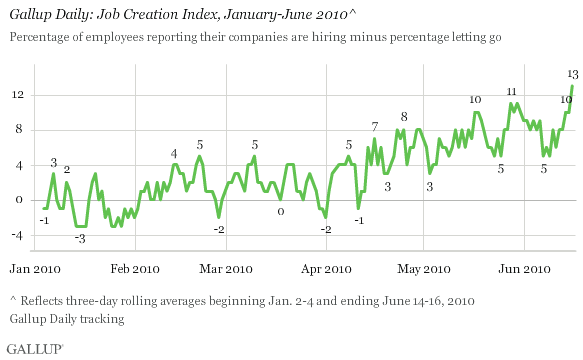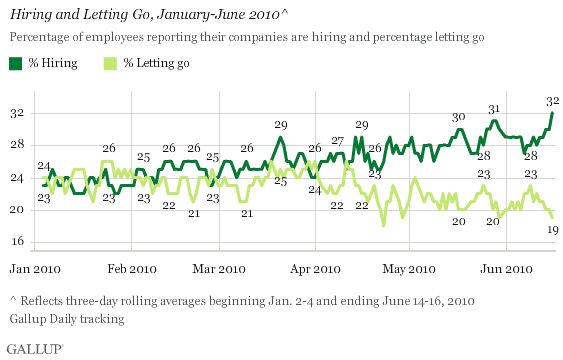PRINCETON, NJ -- Gallup's Job Creation Index hit a 20-month high of +13 on Thursday -- up from +5 a week ago.

More Companies Hiring and Fewer Letting People Go
One-third of employees (32%) now report that their companies are hiring -- also a 20-month high, and up from 28% a week ago. At the same time, 19% of companies are letting people go -- an improvement over the 23% of a week ago.

The Job Situation Is Improving Slowly
The government reported Thursday that jobless claims increased to 472,000 during the week ending June 12 from a revised 460,000 the previous week. While this may be discouraging to those who had hoped for a rapid improvement in the jobs picture this year, it is consistent with the slight downturn in Gallup's Job Creation Index during the week ending June 13. May's Job Creation Index results are also consistent with the government's report that the unemployment rate fell to 9.7% in May from 9.9% in April.
On the other hand, Gallup's Job Creation Index continues to show a slow, if moderate, improvement in job market conditions that is not reflected in the jobless claims data of the past six weeks or in May's private-sector job growth in the government's establishment survey. In part, this may to be due to the seasonal adjustments the government currently applies to its results; Gallup's data are not seasonally adjusted. Of course, the flood of temporary census workers is also distorting the current jobs picture and is picked up, in part, by Gallup's Index. Further, the Index does not reflect the magnitude of hiring, but instead, the percentage of employees who perceive that their companies are hiring. As a result, it could be that, given current economic uncertainties, more companies are hiring fewer employees on average right now than they did in the past.
Regardless of what the government reports concerning the jobs picture, Gallup's Job Creation Index reveals that a higher percentage of companies are hiring right now than has been true at any time since October 2008. Like the mid-June improvement in underemployment, this is good news not only for those looking for a job, but also for the nation's collective economic psyche.
Gallup.com reports results from these indexes in daily, weekly, and monthly averages and in Gallup.com stories. Complete trend data are always available to view and export in the following charts:
Daily: Employment, Economic Confidence and Job Creation, Consumer Spending
Weekly: Employment, Economic Confidence, Job Creation, Consumer Spending
Read more about Gallup's economic measures.
Survey Methods
For Gallup Daily tracking, Gallup interviews approximately 1,000 national adults, aged 18 and older, each day. Gallup's underemployment results are based on more than 20,000 telephone interviews completed on a 30-day rolling basis. For these results, one can say with 95% confidence that the maximum margin of sampling error is ±1 percentage point. Gallup Job Creation Index is based on more than 3,000 telephone interviews completed on a weekly basis. For these results, one can say with 95% confidence that the maximum margin of sampling error is ±3 percentage points.
Interviews are conducted with respondents on landline telephones and cellular phones, with interviews conducted in Spanish for respondents who are primarily Spanish-speaking. Each daily sample includes a minimum quota of 150 cell phone respondents and 850 landline respondents, with additional minimum quotas among landline respondents for gender within region. Landline respondents are chosen at random within each household on the basis of which member had the most recent birthday.
Samples are weighted by gender, age, race, Hispanic ethnicity, education, region, adults in the household, cell phone-only status, cell phone-mostly status, and phone lines. Demographic weighting targets are based on the March 2009 Current Population Survey figures for the aged 18 and older non-institutionalized population living in U.S. telephone households. All reported margins of sampling error include the computed design effects for weighting and sample design.
In addition to sampling error, question wording and practical difficulties in conducting surveys can introduce error or bias into the findings of public opinion polls.
For more details on Gallup's polling methodology, visit https://www.gallup.com/.
